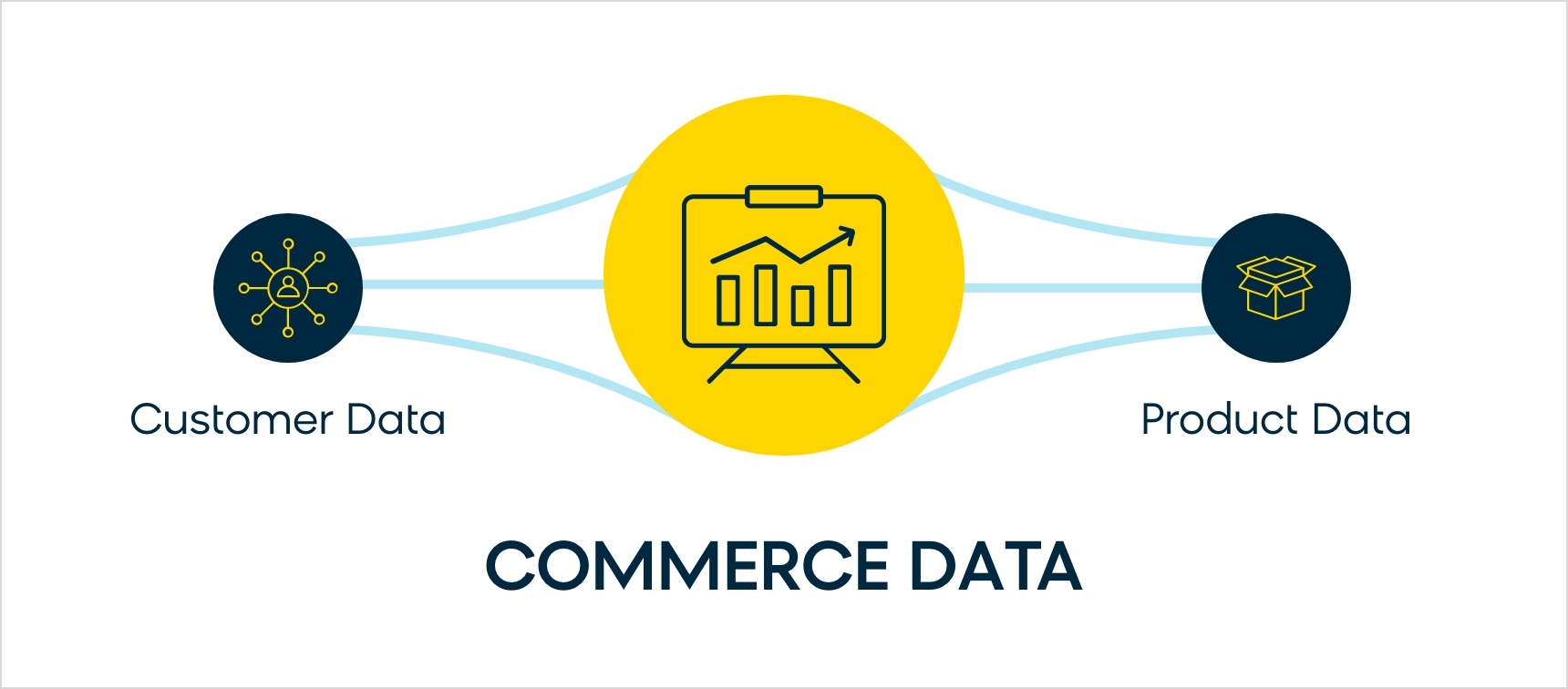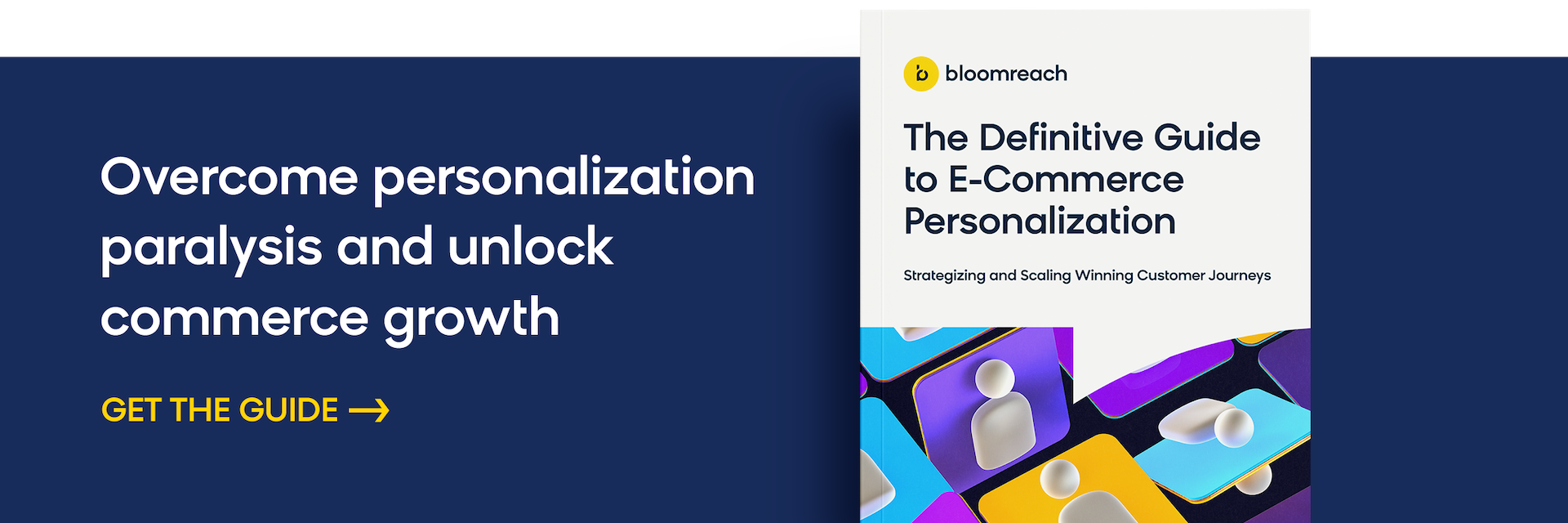What Is E-Commerce Data and Why Is It Important to E-Commerce Personalization?
By Carl Bleich
05/02/2023

One of the most important building blocks of ecommerce personalization is being able to effectively collect and use commerce data.
What is commerce data? A simple equation illustrates it best.

Commerce data is the combination of collected customer data and product data to power truly personalized customer experiences in ecommerce.
Your company’s ecommerce personalization efforts will be incomplete in today’s market without commerce data. If commerce data is represented by a car, the engine of that car is your product data and the gasoline you put in the engine is your customer data. Both are crucial and need to work together for the car to function properly.
Having access to just customer data or just product data is insufficient and will leave your customers longing for more in their journey with your brand. Commerce data is the fuel companies need to strategize and scale winning customer journeys with ecommerce personalization.
The Importance of Commerce Data
Customer data is the personal, behavioral, and demographic data collected by your company on those who shop with you and visit your e-shop. Product data is the information about a product that can be read, measured, and structured into a usable format.
Having access to either customer or product data is essential depending on the nature of your ecommerce business. Having access to both — commerce data — is a key piece of the puzzle when it comes to using personalization to unlock commerce growth.
That’s because the combination of commerce data and the right technology stack can help companies across the world address their need to increase digital revenue while optimizing the customer experience.
If you only have product data, then you’re going in blind when trying to personalize for individual customers. Basing personalization efforts off of inventory counts or sales numbers isn’t the right kind of data you need to create meaningful and memorable customer experiences.
On the other hand, only having customer data still leaves the major gap of connecting customers to your business and products. Knowing a shopper’s preference on t-shirt type or size doesn’t help your bottom line if you can’t connect the shopper to that specific type of t-shirt on a corresponding category page.
That’s why commerce data is step number one in upgrading your ecommerce personalization efforts. It connects customers with the products they desire and helps your company increase revenue and facilitate brand loyalty.
Customer Data
In today’s market, nearly every company collects or buys customer data in some way, shape, or form. It’s nearly impossible to survive without it.
We know that customer data refers to all personal, behavioral, and demographic data that is collected by companies from their customers. Simple enough, right?
But there are key differences in how exactly that data is collected (internally or externally). Let’s take a look at the types of customer data that can be collected to help better understand the importance of commerce data in totality.
First-party Data
First-party data is information about customers that companies directly collect via their own channels and sources. This includes transactional data, demographic data, behavioral data, and anything else that companies collect directly from interactions with customers.
This type of data can come from both online and offline sources. Companies often have different silos of collected customer data and need a customer data platform to help consolidate all of that data into one place and make it useful for in-house marketers.
Second-party Data
Second-party data is another company’s first-party data that has been packaged and sold. Company A collects first-party data from customers and sells it directly to Company B. It is the same type of data as first-party data, but the source is obviously different because of the sale.
Second-party data is valuable because it can help you gain more information about customers. If you are a new company or in your early stages, you may not have much customer data to use. Second-party data can be helpful in building a customer base if the source you are acquiring it from is trustworthy.
Third-party Data
Third-party data is data that has been collected from many sources, aggregated into one dataset, then packaged and sold. Companies that sell third-party data are typically not the companies that collected that data in the first place. Instead, they buy first-party data from many other companies and then bundle it to be sold.
Third-party data can have a major scale advantage over first- and second-party data. However, there are exclusivity issues as third-party data vendors can contract with any company they please to sell their data bundles. Additionally, the data bundles may be low quality or collected in a non-compliant manner.
Zero-party Data
As companies are bound by the limits of legal guidelines and regulations, as well as by their desire to respect customer privacy, the popularity of collecting zero-party data has boomed.
Zero-party data is information that a customer freely provides to a company. It’s not inferred from how customers behave on your site. Rather, it’s explicitly given by a customer, typically with the expectation that giving their data will reward them with a better customer experience.
Frequently asked zero-party data collection questions include “how often do you want to receive emails from us?” and “how was your most recent experience with our brand?”
The answers provided to these questions by consumers fall underneath the umbrella of zero-party data. Companies can use this collected information to provide better experiences for their customers.

E-commerce Product Data
Product data is all of the information about a product that can be read, measured, and structured into a usable format. Having accurate product data is essential, as companies can lose revenue online because of incomplete or inaccurate product data.
Key portions of your product data to have correct and optimized include:
Product Titles
This will more than likely be the first thing shoppers see when they go to your product listing. If the title does not match the product they are looking for or does not inspire them to continue further, shoppers will exit right then and there.
Product Image
While images may not have the impact on product discoverability that other parts of the product data do, they are extremely important when it comes to key metrics like clicks and conversions. Quality product images help customers know what they are getting with the product they are browsing, and many will not purchase without seeing a high-quality image.
Product Category
Discoverability is a key part of your company’s product data. Customers have to be able to find the products that they are looking for with your company. Ensuring that your product data has accurate categories helps consumers find what they are looking for or find related products as they browse.
Product Description
The product description is another major influencer of conversions and clicks. It won’t necessarily help customers find your products, but once they’re on a listing, an accurate and well-written description will help close the sale. Poorly written product descriptions are a major risk to revenue and a turn off to customers.
Bring Commerce Data and Ecommerce Personalization Together With Bloomreach
Bloomreach is the top ecommerce personalization vendor in today’s market because our Commerce Experience Cloud is designed for companies to be able to compliantly collect commerce data and use that data to fuel their ecommerce personalization strategies. We built our product with your company’s personalization efforts in mind.
Our Discovery tool offers AI-driven search and merchandising, while Content offers a headless CMS and Engagement provides a top CDP and marketing automation solution. Together, these platforms form a cloud that serves the most foundational components of the commerce experience in one location, backed by the commerce data professionals need for truly exceptional execution. It’s flexible, gets up and running quickly, and starts driving results right away.
If you’re interested in learning how to start collecting the commerce data your company needs to strategize and scale winning customer journeys, schedule a personalized demo with Bloomreach today.
Found this useful? Subscribe to our newsletter or share it.







